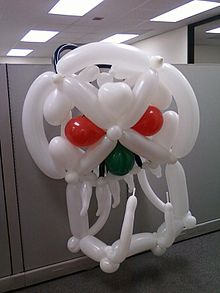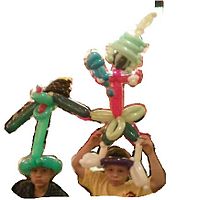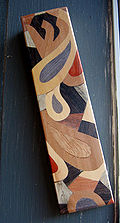- Balloon modelling
-
Balloon modelling or balloon twisting is the shaping of special modelling balloons into almost any given shape, often a balloon animal. People who create balloon animals and other twisted balloon sculptures are called Twisters, Balloon Benders and Balloon Artists. Twisters often perform in restaurants, at birthday parties, fairs and at public and private events or functions.
Two of the primary design styles are "single balloon modelling", which restricts itself to the use of one balloon per model, and "multiple balloon modelling", which uses more than one balloon. Each style has its own set of challenges and skills, but few twisters who have reached an intermediate or advanced skill level limit themselves to one style or another. Depending on the needs of the moment, they might easily move between the one-balloon or multiple approaches, or they might even incorporate additional techniques such as "weaving" and "stuffing". Modelling techniques have evolved to include a range of very complex moves, and a highly specialized vocabulary has emerged to describe the techniques involved and their resulting creations.
Some twisters inflate their balloons with their own lungs, and for many years this was a standard and necessary part of the act. However, many now use a pump of some sort, whether it is a hand pump, an electric pump plugged in or run by a battery pack, or a compressed gas tank containing air or nitrogen. Twisters do not generally fill their creations with helium, as these designs will not usually float anyway. The balloons for twisting are too porous for helium and the designs are generally too heavy for their size for helium to lift.
Contents
Origins of balloon modelling
The origins of balloon modelling are unknown. The 1975 book by "Jolly the Clown" Petri credits "Herman Bonnert from Pennsylvania at a magician's convention in 1939" as being the first balloontwister.[1] Val Andrews, in Manual of Balloon Modeling, Vol. 1, An Encyclopedic Series, credits H.J. Bonnert of Scranton, Pennsylvania as being the "daddy of them all."[2] Jim Church III states, "Frank Zacone from Youngstown, Ohio was doing a balloon act during the 1940s and had been doing the act for some time."[2] Recently ESPN's three time Emmy Award director Joseph Maar has been providing information and materials to balloon history sites that supports his father Henry Maar as the first balloon twister.[3] It is possible that one, none, or all of the above independently crafted the art of balloon twisting.
Equipment
There are two essential items required for balloon twisting:
- First, you need an assortment of balloons, usually in various colors. Balloon sizes are usually identified by a number: the most common size of twisting balloons is called a "260", as it is approximately two inches in diameter and 60 inches in length. Thus, a "260" is 2x60 inches and a "160" is 1x60 inches when fully blown up. Although these are the most common sizes used, there are dozens of other shapes available as well. The most popular balloon brand among professional twisters is Qualatex, manufactured by the Pioneer Balloon Company, but there are many other brands available. Betallic has made strong inroads into the industry by greatly expanding their line of available shapes and colors. Today there is a wide variety of individual sizes and colors to choose from.
- Second, you'll need something to inflate the balloons with. The most common methods are air pumps similar to bicycle pumps, electric air compressors, and via the mouth. Inflating a balloon via the mouth is difficult and can be dangerous. Particularly well-trained and talented twisters, however, can blow-up several balloons at once, and some can even blow up 160s, which are much more difficult to mouth-inflate than the more common 260s, as their narrowness requires a great deal more strength and breath pressure to inflate.
Air pumps and air compressors have only recently been accepted in the twisting community. Fifteen years ago, most balloon twisters blew up balloons with their mouths, and the use of a pump was associated by many as unprofessional. Today, most twisters use some sort of mechanical means to inflate their balloons. There are various reasons for this:
- Most twisters are physically incapable of mouth-inflating hundreds of balloons over an extended period.
- There are possible health risks to the twister associated with blowing up balloons by mouth. The pressure involved in the activity can cause the twister to become lightheaded or even pass out. A balloon that is popped while blowing up can snap back and damage the eyes. In rare cases, the pressure can damage the ears, eye or the muscles around the throat.
- There are also hygienic issues involved: many twisters and parents are uncomfortable handing a child something that has been in the twister's (or anyone's) mouth. Some believe that when a blown-up balloon pops, the germs of the twister are spread further and faster than they normally would be.
- Finally, many twisters prefer to avoid being a bad role model by putting a balloon in their mouths around children. Balloons do pose a choking hazard for small children, and are usually marked with hazard warning labels for children under the age of eight. (Note, older balloon twisters often use their mouths for other purposes such as creating small balls or deliberately popping sections of the balloon. Children frequently mimicked this posing a choking hazard.)
Simple techniques
As the twister inflates each balloon, he or she may leave some of the balloon uninflated at the end, leaving a "tail". The tail is necessary for most creations because it gives the pressurized air someplace to go while manipulating the balloon, reducing the chance of the balloon popping due to necessary pressure during the twisting process. The length of the tail is different for each creation, and knowing how much to leave becomes part of learning or creating the design.
The first animal most people learn how to create is the basic dog.
-
- Inflate and tie a 260 in the color of your choice, leaving about 4-5 inches of the balloon uninflated.
- Twist 1: Starting at the nozzle (tied-off) end of the balloon, create the snout by moving the hand up about 4 inches from the knot, pinching the balloon to create a closed-off "bubble", then twist at that point 2-3 times. (Do not let go of the balloon, or it will come untwisted.)
- Twist 2: While holding onto the snout, move your hand up the balloon another two inches, then pinch and twist as before to create another bubble. Don't let go.
- Twist 3: Create a third bubble the same size as the second, forming the two ears. Don't let go.
- Folding the balloon between the two ear bubbles so that the ears are lying side by side, twist 1 and 3 together 2-3 times: this forms a "lock twist". (Now you can let go: the ears are locked in place.)
- Make a small bubble (1 - 1 1/2 inch).
- Make 2 bubbles about 3 inches each and lock twist at the neck bubble.
- Make a 3 inch bubble followed by 2 3-inch bubbles for the back legs.
- Trim the tail if needed.
(Getting the proportions right will become easier with practice.)
Most simple animal designs are variations on the basic dog. A 'wiener dog' is a dog with a long body and short legs, a giraffe is a dog with a long neck and so forth.
Decorating
To finish the creation the twister might use a felt-tip marker to draw a face on the dog. The most common marker used on latex is a Sharpie, a common brand of permanent marker. Other markers can be used as well. If you wish to try another kind of marker on your balloons, it is wise to test them beforehand to make sure they react well with the latex. Some markers do not dry on the latex, and smear long after being applied, which is the case with some brands of dry erase markers. Other markers contain an acidic ink that reacts with the latex, causing the balloon to pop.[citation needed] Cheaper markers may also have badly-shaped tips which can pop balloons.
Blowing up a "260" by mouth
NOTE: Blowing up a 260 or other twisting balloons can be dangerous (see above). Proceed with caution and at your own risk.
A twister mouth-inflating a 260 balloon will typically do the following:
- Hold cheeks in, creating a funnel shape with the mouth. A common mistake is to puff the cheeks out while blowing up the balloon, causing undue stress on the cheeks and sometimes resulting in pain.
- With the left hand, hold the nozzle of the balloon firmly but openly, putting the nozzle to your mouth. This hand will remain stationary until the balloon is inflated. Do not hold the balloon so tightly that it seals shut: air must be able to enter the balloon.
- With the right hand, grab the balloon 3-5 inches away from the nozzle, sealing the balloon at that point and creating a smaller section in the balloon. (This reduces the amount of pressure required to inflate the balloon, as longer balloons are harder to blow up than their shorter counterparts.)
- Blow into the balloon, pulling the right hand away from the face while maintaining the seal and stretching the sealed-off section. The balloon should start to expand. The twister will typically release the right hand after the entire 3-5 inch section is inflated. Once the balloon has started to expand, the rest of the inflation becomes easier. While an experienced twister can inflate an entire 260 with one breath, most beginners require 2-3 breaths to inflate the balloon after getting it started.
NOTE: Stretching the balloon prior to inflation does not significantly ease the process.
There are various reasons that some people can blow up balloons with their mouths, while others can't. Many older, experienced twisters are quite adept at mouth inflation because that method was the standard for many years. More men tend to inflate by mouth than women, and bigger people are more likely to blow up balloons with their mouths than smaller people. Also, while a 10-year old tuba player can probably blow up this type of balloon, most people under the age of 20 do not have the physical strength to blow up a 260 without a pump.
Techniques
Inflation
The familiar long, narrow balloons used by modellers require some practice to inflate properly, both because of the high pressure required and the experience needed to judge how much air to add. A length of full but not inflated (FBNI) balloon is generally left at the end, since air is forced out of the inflated portion as work progresses. The amount of twisting to be done determines the quantity of air that can safely be added before the balloon is tied shut (each twist uses up some spare FBNI).
Pinch-and-twist
The balloon is pinched off and then twisted through several rotations to form isolated bubbles. This should begin at the nozzle end of the balloon, so that FBNI material is always available to one of the bubbles being pinched, preventing a buildup of pressure.
Locking twist
Three pinch-and-twists result in four bubbles (with the last typically being the remainder of the balloon). If the first and third twist are brought together and twisted, the result will lock together, with two bubbles joined at their ends, and two free bubbles. This is also the standard "dog's head" twist. Additional security for the twist is added if one of the two free bubbles is passed between the two bubbles joined at their ends. Some call this a "security lock."
Fold twist, ear twist, pinch twist, or bean twist
Similar to the locking twist, but using only three bubbles: the center section is folded gradually, rather than hinging sharply at a twist. These can be made much smaller than locking twists, so that the center section resembles an ear or bean, but they are able to lock in a similar way.
Bird body or three bubble roll-through
This begins with a locking twist, using relatively long bubbles. Another pinch-and-twist produces another bubble, which is "rolled through" the opening between the two joined bubbles, to produce another locking twist at the opposite end.
Apple twist, tulip twist, or hook twist
The nozzle end of the balloon is inserted into the inflated balloon, by turning a short section of the balloon inside-out. The knot is then trapped in a pinch-and-twist, leaving a vaguely torus-shaped bubble. The inverted section of the balloon applies tension, and can hold relatively long bubbles. The hook twist also uses the knot to lock the twist instead of a bubble. The hook twist is created by pulling the knot down along the side of the balloon, where it is locked by a pinch twist to the remaining balloon length. A common use of the hook twist is to create a parrot's head. It is also commonly used to create various hair effects on balloon sculptures. Variations include the yo-yo twist and marriage twist (see reference).
Poodle tail
Air is forced through the remaining length of FBNI balloon and allowed to inflate a small section at the end of the balloon. The is accomplished by applying gentle pressure to the FBNI above the bubble, preventing it from inflating, then firmly squeezing the bubble forcing the air up.
In the past, this was covered by simultaneously sucking the end of the tail, apparently causing the bubble to appear. However, because of the risk of children attempting to repeat the feat or otherwise placing balloons in their mouth, this is generally discouraged today. An alternative gimmick is to have the performer or child blow on the end of the balloon, apparently inflating it from outside.
Pop twist
The pop twist is typically used to create extra "ends" of the balloon, for instance for creating arms for a teddy bear or other character. In this case, after the neck bubble, twist one longer bubble (one arm), three 1/2 inch bubbles (two hands and a spare which will be popped), and a second longer bubble (the other arm) which is twisted to the first, creating a ring of 5 bubbles. Now ear twist the first and third of the smaller bubbles, approximately 5 full rotations each - they should be taut against the longer bubbles. Using one hand to hold all bubbles firmly, use a pair of scissors (or pin, pocket knife, etc.) to pop the centre small bubble. Carefully release the two arms, ensuring that the hands stick by friction and don't unravel, revealing two separate arms and hands.
The pop twist is less durable than most other twists, and so may not be suitable for children's balloons, but can be used to create many impressive character pieces.
Common models
Single balloon
- Basic four-legged animal: Three locking twists. The first forms nose, ears/face, and neck; the second, front legs and body; the third, back legs and tail. Different proportions can be used to represent a dachshund, a giraffe, etc.
- Elephant: A hook twist trunk followed by a bean twist face and two large "elephant ear" twists, finished with two locking twists as above.
- Monkey
- Bear
- Helmet: Three bubble roll through sized to fit a person's head.
- Sword: Twofold twists form the cross piece, with one short and one long bubble forming the handle and blade.
- Tommy gun
Multiple balloon
- Characters
- Monkey on palm tree
- Penguins
- Big dog
- Bear on heart
- Octopus
- Flowers
- Mask to wear
References
- ^ Dewey, Ralph. Balloon History BalloonHQ Column. Accessed 10/5/07
- ^ a b Andrew, Val. Manual of Balloon Modeling, Vol. 1, An Encyclopedic Series 1981, Magico Magazine, NYC quoted on Balloon History BalloonHQ. Accessed 10/5/07
- ^ Maar, Joseph.The Story of Henry Maar TMyers.com 6/20/06 Accessed 10/5/07
External links
- Busker Alley - Videos of balloonatics in action
- BalloonHQ
- FAQ on Latex Free alternatives
- Balloon Twisting Instruction Videos
Categories:- Art media
- Balloons
Wikimedia Foundation. 2010.









